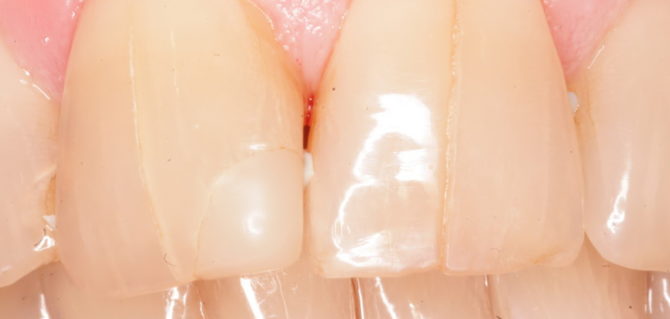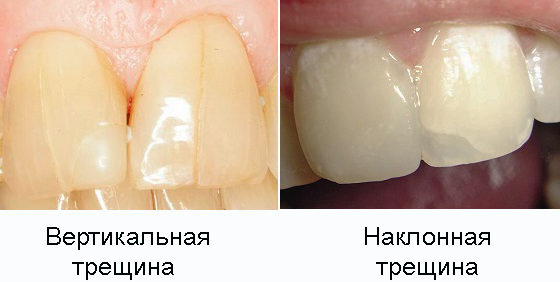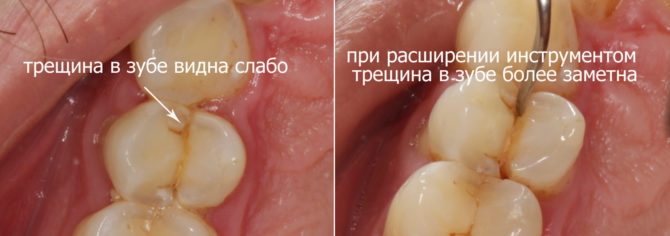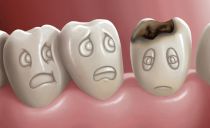Enamel Cracks: Causes, Symptoms and Treatment
Only a doctor knows what to do when cracks appear on tooth enamel. therefore when the first signs of a split of the tooth surface occur, consult a dentist. Most often, this pathology is associated with internal problems in the body, so it cannot be eliminated with medical toothpaste and rinses: serious therapy is required.
Content
What is a tooth crack
A tooth crack is a split in enamel. Sometimes the pathological process affects the tissue of dentin, sometimes not. But the molar itself during the split is not broken, does not stagger and is not pigmented.
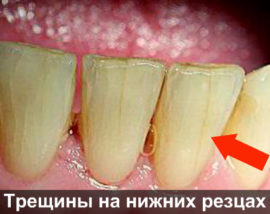 Cracks in tooth enamel provoke pain. They come in many shapes and sizes. Small filiform grooves are found only at the dentist's appointment. Larger ones are visible to the naked eye, they are especially pronounced after drinking coffee, tea or drinks with dyes.
Cracks in tooth enamel provoke pain. They come in many shapes and sizes. Small filiform grooves are found only at the dentist's appointment. Larger ones are visible to the naked eye, they are especially pronounced after drinking coffee, tea or drinks with dyes.
Splitting the enamel layer of a molar, canine or incisor requires medical intervention, even if it is very small. A small crack on the tooth enamel can increase and lead to complete tooth loss.
As a result of the enamel crack, a channel can form, reaching the pulp. A canal is actually a hole in a tooth into which leftovers of food and saliva fall. To clean the canal with a toothbrush or rinse is extremely difficult, so after some time inside it develops caries.
Reasons why cracks appear on tooth enamel
There are several reasons why enamel crack on teeth. Most often they include:
- injuries
- bad habits;
- excessive consumption of solid foods;
- bruxism;
- the habit of picking with toothpicks or foreign objects in the mouth;
- non-compliance with oral hygiene;
- cracking solid foods, cracking nuts, untying shoelaces, opening bottles with teeth;
- malocclusion;
- regular use of certain medications, the components of which are able to corrode enamel or penetrate saliva;
- sharp temperature changes, for example, when a cold drink is consumed after hot food;
- the use of citrus juices, soda and various foods with chemical dyes;
- smoking;
- the use of whitening toothpastes, since they contain components that thin the enamel.
If the dentist places unsuitable fillings or makes a mistake in choosing an implant, vertical or horizontal cracks may also appear on the teeth.
Classification of cracks in tooth enamel
Depending on the cause of education enamel crack can occur in different directions. The following splits are distinguished:
- Internal, which is visible only on x-ray.
- Inclined, located diagonally.
- Horizontal, as a result of which a piece of enamel can break off.
- Vertical, located vertically. A crack runs along the entire molar and sometimes continues even inside the gum.
Auxiliary symptoms
Enamel defects are not always visible to the naked eye.Sometimes microcracks occur on the surface of the teeth, which can only be detected by a dentist during an instrumental examination. But it is better to identify them at the initial stage of development, since the daily load on the damaged chewing surface of molars, incisors and canines will lead to the expansion of splits.
The main signs of cracks in the teeth:
- the occurrence of a slight pain syndrome when eating too hot or cold food;
- aching pain that appears occasionally and in the absence of an external irritant;
- the appearance of a small colored net or strip on enamel after drinking coffee and tea.
If you ignore these symptoms, caries will form on the damaged enamel, the gums will swell, and there will be bad breath. In the future, not the crown will crack, but the tooth root.
Diagnostic Methods
When the first symptoms of pathology appear, consult a doctor. If there is a suspicion of microcracks on the enamel, the dentist will conduct a microscopic examination of the dentition and identify defects present on it. During the diagnosis, the doctor can use a special dye that can show even the smallest cracks.
During the study, the doctor collects an anamnesis from the words of the patient and the data of his medical record to identify the cause of the formation of cracks in the teeth. Studying the patient’s medical history will help the doctor distinguish pathology from other diseases and establish the need for a more serious diagnosis to identify internal splits of dental tissues.
In addition to the above, the dentist evaluates the condition of the soft tissues of the oral cavity. Swollen gums indicate tooth problems.
After a visual examination, the patient may be given a special dental brush. It looks like a regular toothbrush, but does not have bristles. A person should bite her daily (every day with a new tooth) and fix his feelings. The tooth unit that is most cracked will give the most painful reaction to the experiment.
If internal splits are suspected, a jaw radiography is performed. It helps to identify chronic defects and cracks in the tooth roots.
Treatment of horizontal and vertical cracks in tooth enamel
The tactics of tooth treatment depend on the size and location of the crack on the enamel:
- Cracks and bumps on the enamel most often occur due to the presence of old fillings. In this case, the fillings are removed, the tubercles are cut off, the cracks are polished, and the damaged crown part of the tooth is restored with filling materials.
- In the presence of cracks and chips on the front teeth, the fillings are best made from light-cured materials, as they harden faster, are more durable and most aesthetic.
- Transverse cracks most often occur on the lower molars and premolars. Usually they cause serious damage to the tooth, so crowns are used to restore it.
- Fully split teeth must be removed because they are a source of infection and can lead to infection of the soft tissues of the oral cavity or to tooth decay in other parts of the jaw.
- If the tooth cracked vertically, endoprosthetics should be done. Sometimes this treatment tactic does not bring the desired result and even worsens the condition of the bone tissue. With a vertical crack at the root, the tooth definitely needs to be removed.
Why tooth extraction is required if it is cracked badly
If for medical reasons it is required to remove a tooth, then it is better not to try to save it. After a certain time, such a dental unit will still have to be removed, but during the restoration procedures a lot of bone tissue will suffer, which will make possible the implantation and even prosthetics.
It is necessary to remove a strongly cracked tooth for one more reason - the presence of an inflammatory process in the oral cavity will negatively affect the condition of the remaining teeth.
What to do if milk tooth is cracked
Milk teeth can also crack. Moreover, this phenomenon is quite common, since children often pull toys and foreign solid objects in their mouths.
If the tooth cracked horizontally, it is better to remove it. Otherwise, it can be sanded and protected from participation in the chewing process. The fact that a milk tooth has cracked does not mean that a permanent tooth will have the same defect.
What to do if there is a microcrack on the enamel of the front tooth
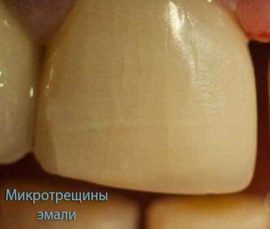 If the enamel is slightly cracked on the front tooth, you need to urgently go to the dentist. It is a misconception that microcracks on teeth do not require special treatment. If you leave this defect unattended, you may encounter the need to remove the dental unit. Therefore, small cracks should be treated.
If the enamel is slightly cracked on the front tooth, you need to urgently go to the dentist. It is a misconception that microcracks on teeth do not require special treatment. If you leave this defect unattended, you may encounter the need to remove the dental unit. Therefore, small cracks should be treated.
Microcrack treatment regimen:
- Microscopic layers of enamel are gradually removed, which allows you to remove all cracks.
- The defective area is polished and polished using special devices and materials.
- The problem area is covered with fluoride varnish.
Tooth treatment with fluoride varnish will help to get rid of cracks only in the absence of any diseases in the oral cavity. Otherwise, the infection can get inside the tooth, because of which it can completely crack. First you need to treat caries, and only then cracks and breaks on the enamel.
What to do at home if a crack appears on the tooth
If a crack appears on the tooth, it is necessary to treat the oral cavity with any antiseptic to prevent the development of inflammation. If the tooth is very sore, you can take an anesthetic.
In the presence of cracks in the enamel, it is better to refrain from eating food, or at least not chewing on the sore side. In the event of a deep fracture or a vertical crack on the front incisor, one should refrain from brushing teeth before being consulted by a dentist.
In no case should you try to independently restore the integrity of the tooth or set it in place. Attempts to cure a molar, incisor or canine on their own will lead to the removal of not only the victim, but also adjacent teeth. Only a dentist knows how to treat cracked teeth. If a problem occurs, you need to seek qualified medical help at a dentistry clinic.
Preventive actions
To prevent the appearance of cracks and crevices on the teeth, it is recommended:
- brush your teeth regularly;
- use mouthwash and balm for the oral cavity;
- choose a brush of medium hardness;
- use toothpastes with fluoride and calcium;
- eat well;
- Avoid temperature changes during meals.
It is necessary to periodically examine the teeth and monitor their own sensations. Suddenly, the enamel does not crack, there is always some long-standing reason for such a phenomenon.
If the tooth still burst, you need to go to the dentist. There is no other way to preserve a molar, incisor or canine in the presence of deep cleavages. No folk remedies will remove the cracks and restore the enamel.

